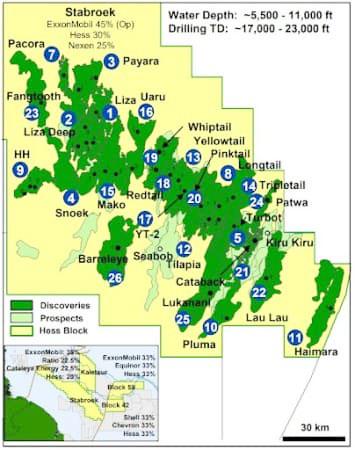Latest update November 25th, 2024 1:00 AM
Latest News
- ExxonMobil commences design for 7th project as Gov’t remains ‘iffy’ over approval
- Gov’t extends deadline for proposals on second phase of Gas-to-Energy project
- Hezbollah rockets land near Tel Aviv after big Israeli strike on Beirut
- 121 drivers nabbed speeding, 248 with unauthorised tinted glass
- Cop stabbed by Venezuelan national
“Extremely favourable terms” allowing Exxon to ramp up production in Guyana – energy news site
Nov 10, 2022 News
(OIL PRICE.com) – After a swath of high-quality oil discoveries by an ExxonMobil-led consortium in offshore Guyana, which have identified at least 11 billion barrels of recoverable oil resources, have catapulted the impoverished South America country firmly onto the global oil map.
The offshore Guyana-Suriname Basin is being called the world’s most exciting oil frontier seeing it attract considerable attention from global energy companies. Despite industry infrastructure shortfalls and other constraints there are clear indications that the oil boom which has delivered a massive economic windfall for Guyana is primed to explode. Exxon only roughly a week ago announced two additional oil discoveries in the world class 6.6-million-acre Stabroek Block offshore Guyana which now sees over 30 discoveries in that block alone. Other energy companies are investing heavily in offshore Guyana, which is a jurisdiction that has some of the lowest operating costs in South America. Guyana is poised to emerge, before the end of this decade, as a leading global oil producer and exporter.
Exxon’s latest oil discoveries in offshore Guyana were with the Sailfin-1 and Yarrow-1 wells in the Stabroek Block. Sailfin-1 encountered 312 feet of hydrocarbon bearing sandstone while Yarrow-1 only found 75 feet. That brings the number of discoveries made by the Exxon led consortium, where the energy supermajor is the operator holding a 45% interest with 30% controlled by Hess and the remaining 25% by CNOOC, in the Stabroek Block to 35 since 2015.
The Exxon led consortium secured extremely favorable terms from Georgetown for the development of the Stabroek Block, with some analysts describing it as one of the most advantageous production sharing agreements ever obtained. For that reason, those operations will be highly profitable for Exxon, as well as partners Hess and CNOOC, because of forecast industry low breakeven prices of $25 to $35 per barrel Brent. It is for tis reason that Exxon is investing heavily ramping up activity in the Stabroek Block with many projects ahead of schedule. The block is expected to become a major growth driver for the global energy supermajor.
Exxon has ramped up activity in the Stabroek Block with the Liza Phase 1 and Liza Phase 2 operations now producing at above nameplate capacity to be pumping a combined total of around 360,000 barrels of petroleum per day. The integrated energy supermajor is working on other projects in the Stabroek Block. These include the 220,000 barrel per day Payara project which was approved by Guyana’s government in Georgetown during September 2020. It will add a third production, storage and offloading (FPSO) vessel, named Prosperity, to the two FPSOs working in the Liza oilfield. Payara will have 41 wells, 20 production and 21 injection wells with start-up anticipated during 2023. Then there is the Yellowtail development which is planned to have 51 wells, 26 production and 25 injection wells. Yellowtail, which will have nameplate capacity of 250,000 barrels per day, will add a fourth FPSO to Exxon’s operations in the Stabroek Block. It is anticipated that the project will commence production during 2025. Exxon expects to be pumping one million barrels per day from the Stabroek Block by 2030. Related: Saudi Arabia Cuts Oil Prices For Asia
Guyana is garnering considerable attention from international energy companies. Canadian intermediate oil producer Frontera Energy, which announced in May 2022 a light oil and condensate discovery in the Corentyne Block with the Kawa-1 well, is committed to spending $186 million in Guyana during 2022. That represents an increase of $46 million from the driller’s initial budget of $140 million. The northern section of the Corentyne Block is adjacent to the prolific Stabroek Block and believed to share that block’s petroleum fairway which bodes well for further discoveries. Frontera holds a 68% interest in the block with subsidiary CGX Energy, the operator, controlling the remaining 32%.
The driller from its $186 million 2022 Guyana budget has allocated $51 million to the Kawa well, $100 million to $130 million for drilling the Wei well and $5 million to the Guyana port project. The Kawa-1 well encountered 228 feet of net pay with the geological structure found to have similarities to oil discoveries made in the neighboring Stabroek Block. The Wei-1 well, which is roughly 9 miles northwest of Kawa-1, will be spudded during fourth quarter 2022 with CGX stating in July 2022 that drilling was to proceed. Frontera confirmed plans to drill the Wei-1 well in its August 2022 Corporate Presentation. The intermediate oil producer stated drilling was to commence during October 2022 subject to the rig being released by a third party. CGX’s northern Corentyne block 3D seismic survey coupled with the successful Kawa-1 well and nearby oil discoveries in the neighboring Stabroek Block to the northeast and Block 58 offshore Suriname to the west underscore the block’s considerable potential.
These latest developments indicate that Guyana’s oil boom will see the country become a major oil producer in Latin America, that will one day rival nearby Brazil, the region’s leading petroleum producer. To ensure that the former British colony’s oil industry keeps growing at an impressive pace Georgetown is focused on building out the required infrastructure to support the petroleum industry. Construction of Guyana’s first deep water port on the country’s eastern coast on the Berbice River was started by CGX back in 2021 with the multi-million-dollar facility, which has already cost the company $21.8 million, to be complete by 2023. On commencing operations, the port will be a key component of the infrastructure underpinning Guyana’s burgeoning oil boom, while supporting the two existing oil and gas ports, because it will the country’s only deep-water facility. In October 2022 Georgetown announced the tender process for Guyana’s first oil refinery. Guyana’s government is seeking proposals to finance, design and build a 30,000-barrel-per-day facility on state land near the Berbice River, which will further bolster the importance of CGX’s port.
It is easy to understand Georgetown’s eagerness to ensure that critical infrastructure required by Guyana’s petroleum industry is being constructed when the considerable economic windfall that has already been delivered is considered. During the 2020 pandemic, when nearly every other country saw economic growth collapse, Guyana’s gross domestic product soared by a whopping 43.5% which then grew by another 23.8% during 2021. The IMF has predicted that Guyana’s GDP will expand by an impressive 57.8% during 2022 which is by far the fastest rate of growth in the world and Guyana’s economy has held that title since 2020. Those impressive economic performances will continue as Guyana’s oil production and exports continue to expand with the country expected to be pumping as much as one million barrels of crude oil by 2027. (Matthew Smith is Oilprice.com’s Latin-America correspondent. Matthew is a veteran investor and investment management professional. He obtained a Master of Law degree and is currently located in Latin America. Matthew writes on oil and gas, mining and infrastructure.)
Share this:
- Click to print (Opens in new window)
- Click to email a link to a friend (Opens in new window)
- Click to share on Facebook (Opens in new window)
- Click to share on WhatsApp (Opens in new window)
- Click to share on Twitter (Opens in new window)
- Click to share on Pinterest (Opens in new window)
- Click to share on Pocket (Opens in new window)
- Click to share on Tumblr (Opens in new window)
- Click to share on Reddit (Opens in new window)
- Click to share on LinkedIn (Opens in new window)
Related
Similar Articles

The Glenn Lall Show | November, 20th, 2024
Follow on Tik Tok @Glennlall
THE BLUNT OF THE DAY

Sports
Nov 25, 2024
…Chase’s Academic Foundation remains unblemished Kaieteur Sports- Round six of the Republic Bank Under-18 Football League unfolded yesterday at the Ministry of Education ground, featuring...Features/Columnists
The business class also funds undemocratic parties
…Peeping Tom Kaieteur News- There’s a peculiar phenomenon in Guyana, a sort of cyclical ritual, where members of... more
Rising Gun Crimes in the Caribbean: Urgent Action required by all
By Sir Ronald Sanders Kaieteur News – There is an alarming surge in gun-related violence, particularly among younger... more
Publisher’s Note
Freedom of speech is our core value at Kaieteur News. If the letter/e-mail you sent was not published, and you believe that its contents were not libellous, let us know, please contact us by phone or email.
Feel free to send us your comments and/or criticisms.
Contact: 624-6456; 225-8452; 225-8458; 225-8463; 225-8465; 225-8473 or 225-8491.
Or by Email: [email protected] / [email protected]
Weekend Cartoon
















